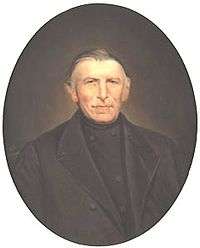Antoon Jurgens

Antoon Jurgens was a Dutch merchant and industrialist, born in Oss, The Netherlands in 1805, and died there in 1880. He founded a butter company that grew to be one of the largest butter and margarine companies in Europe. His company was instrumental in the formation of Margarine Unie which, in 1930, merged with Lever Brothers to form Unilever.
Family
He was the son of Wilhelmus Jurgens and Henrica van Valkenburg.[1] Wilhemus, Leonard and Jan were brothers from Nieuwenhagen who came to Oss at the turn of the nineteenth century. Jurgens uncle, Leonard also married a member of the Valkenburg family, the van Valkenburgs were one of the biggest trading families in Oss.[2] Under the Jurgens, the van Vankenburg business expanded.
On 19 May 1832 Jurgens married Johanna Lemmens: then had ten children.[1]
Civic activities
From 1844 to 1850 Jurgens was a member of the Council of Oss.[1]
Business activities
Jurgens was educated to be a merchant, and in 1820 became a butter merchant in Oss, the Netherlands. The demand for butter increased because of the Belgian Revolt, which caused a large number of soldiers to be stationed in that part Noord-Brabant of the Netherlands. After his father's death in 1836, he and his brothers continued the family company.[1] In 1854, Jurgens and his brother, Johannes formed Gebroeders Jurgens, a partnership specialized in butter trader. Between 1850s and 1860s, a rise in the value of butter to British and German citizens increased the brothers wealth,[2] while the brother largely concentrated on servicing those markets, trade in the home market. Increased demand led to shipment of supplies were obtained in Germany and Austria.
In a notary document of 25 April 1867, he and his sons Jan, Hendrikus, and Arnoldus, formed a limited company under the name Antoon Jurgens, to actively pursue wholesale trade in butter, and to create a dairy farm. Hendrikus was their accountant,[3] Jan was the salesman and Arnoldus was in charge of the technical aspects of the business. They bought butter in the Netherlands, Germany and Austria. The butter was brought to Oss, where it was treated, packed and shipped.[1] The Prussian-Danish and the Austro-Prussian wars increased the price of butter without a significant impact in transporting the product. In May 1871, through the butter industry Jurgens met Hippolyte Mege-Mouries, a Frenchman, who had invented margarine. Mege-Mouries had licensed his patent to business in other countries but not to anyone in the Netherlands, as the Netherlands did not have a patent law until 1910. Jurgens paid for a demonstration of Mege-Mouries' process. Later that year Jurgens started experimental production of margarine to which initially real butter was added.[1]
Retirement
Around 1875 Jurgens wound down his activities in the company. As a Roman Catholic he bequeathed, in 1876, a head altar to the Great Church of Oss, the Netherlands.[1]
Business legacy
The company became one of the largest butter and margarine business in Europe. It was one of the two companies whose merger, in 1927, sparked the formation of Margarine Unie, which three years later, in 1930, joined Lever Brothers to create Unilever.[4]
Descendants
Antoon Jurgens and his wife Johanna Lemmens had 10 children, of whom three sons who continued the margarine factory after his death in 1880. They were:
- Johannes Arnoldus Jurgens (1835–1913)
- Hendrikus Leonardus Jurgens (1840–1888)
- Arnoldus Jurgens (1842–1912)
References
- 1 2 3 4 5 6 7 "Antoon Jurgens (1805-1880)". Thuis in Brabant. Retrieved 14 April 2017.
- 1 2 1914-, Wilson, Charles, (1970). The history of Unilever: a study in economic growth and social change,. Cassell. ISBN 9780304936045.
- ↑ Nederlandse Staatscourant, 6 augustus 1867
- ↑ "Organisation introduction". Retrieved 14 April 2017.
Further reading
- "Jurgens Generaties in Beweging" ( Generations on the move) by M.A.J.Jurgens and drs. F.J.M. van de Ven, Volume I (Family History) and II (Company history)
- Nederlands Patriciaat,Ao 1999, 82e Edition.Genealogy of the Jurgens family
- Nederlandse Staatscourant, 6 augustus 1867